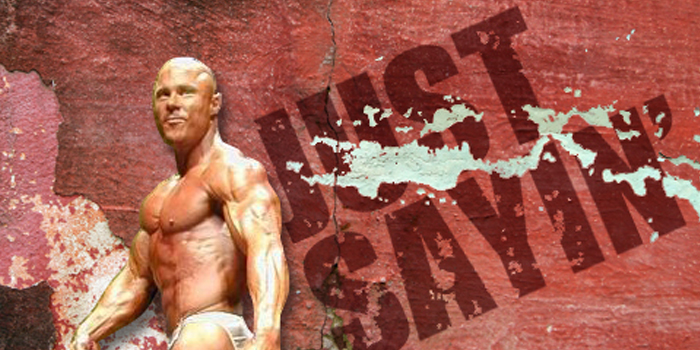
As much as I was looking forward to writing something that would piss a lot of people off this month, I have been getting so many questions lately about muscle imbalances I figured I better focus on that instead. Make no mistake, I will be back in my next article to write something that proves beyond a shadow of your doubt that I am an idiot and unworthy of writing for anyone, let alone elitefts.
I can relate to the questions of muscle imbalance because even though it was over 30 years ago, I vividly remember sitting in the gym after the lights were turned out—myself the only one left in the gym—and thinking I would never be Mr Olympia because of the different cut from my left pec to my right. Clearly, I was correct with my prediction. However, I was unaware at the time that there would be many other reasons that would keep me from winning the Mr. Olympia than just a subtle difference in pec shape. A kid has to dream, right?
RELATED: Correcting Asymmetries: Unilateral Work Versus Integration
The reality is that we all have slightly different shape from the left to the right side of our body. Most everyone has strength imbalances, as well. This is quite common considering we tend to favor our strong side in daily activities, including activities that involve work or hobbies. From a bodybuilding standpoint, this can put symmetry in jeopardy but here is a little secret that most people tend to miss: the imbalances that you see in your own physique—that appear to be glaring issues of asymmetry—are rarely noticed by others until you say something. Even then, most responses to your query will be something along the lines of, “I can’t even tell the difference.” I have been competing for too many years to count and I am an NPC judge and I have clients say something about an imbalance and I have to go back to their pics and look closer only to think, “What in the hell are they talking about?”
Admittedly, some imbalances are more obvious than others, as Rich Gaspari’s one bicep was clearly more developed than the other and other top bodybuilders have had obvious differences from right to left as well, from a lat, to a delt, to a quad or calf muscle. I am not including those that have had muscle tears or tendon ruptures because I consider those to be a completely different situation. I am talking specifically about the shape that you were born with and that hasn’t been altered by injury.
Accepting an imbalance is one thing, but most still want to at least attempt to rectify the problem and just as frequently as I hear someone say they have a terrible muscle imbalance, they are just as quickly asking what they can do about it and how to train to improve the balance from right to left. Though I strongly believe that there will always be differences from side to side even on top bodybuilders, I do agree that an attempt to at least lessen the differences from right to left would be a good move. What is equally as important is to be sure the way you train isn’t actually perpetuating the imbalances.
We all see it quite a bit in the gym: The guy that takes a set so far that while benching, one arm dips so much that you wonder how in the hell the plates stay on the bar. Or the kid that while doing side laterals with dumbbells has one arm/elbow that doesn't go anywhere near as high as the other for the last several reps. Training in this fashion only perpetuates the weakness or imbalance. Sure, both sides can continue to get stronger but when you have one side at a seven and the other side at only a five, they both may increase to nine and seven but there is still going to be an imbalance. What you want to do in a situation like this is train the weak side to catch up while only maintaining the strong side. And if you wonder how I went from discussing poorly or underdeveloped muscles on one side of the body to strength imbalances on one side of the body, these two are intertwined. You will almost never have an underdeveloped muscle that is stronger than its counterpart. This is incredibly rare, to the point that it isn’t even worth discussion in this article.
Specifically, how do you train the weak side? First, I will tell you what you shouldn’t do. I do not recommend training one side harder or with more weight or with more reps. Even if this were to work, it would be too hard to gauge how much work is too much and how much is enough. With this type of training it would be a crapshoot as to whether you were doing enough (or not enough) because there is nothing to reference or compare. You also do not want to used fixed machines where there is no balance from left to right. What I mean by this is if you push on the left side of a fixed machine and the right side moves, as well, this type of machine isn't going to help your imbalance issues. You should be using a barbell, dumbbells or a machines that is considered "iso-lateral" so that both the right and the left function and move independently of each other. Otherwise, if you used a fixed machine, your strong side will certainly take over and do more work as the set progresses and you will not notice this because one side of the machine cannot dip or show any sign of your weakness. Using barbells, dumbbells or iso-lateral machines will show the imbalance. It will be obvious.
Barbells, dumbbells and iso-lateral machines show when the weak side lags behind so knowing when to stop the set is incredibly important if you want to train the weak side to catch up to the strong side. The set should be performed until there is any indication that the weak side is failing. If you perform eight reps that are even from left to right and the ninth rep starts to dip on the weak side, the set should be concluded immediately even if you can get more reps that aren’t even. Why? You have now taken the weak side to the point where it is starting to fail; the weak side has now been provided with stimulus for growth while the strong side has not, thus, the strong side will simply maintain strength and development. Sure, the strong side won‘t get stronger but that is the point. Eventually, training this way will allow the weak side to catch up and when that happens and strength balances out, growth will then move forward for both the right and left sides, equally, and both sides will fail at the same time.
It is important to note that when you have an imbalance from left to right, the longer you take to correct this imbalance with proper training you are going to not only continue to keep this imbalance, but this imbalance will contribute to other imbalances. An example would be a weak pec that will start to rely on the delt complex—and possibly the lat and tricep on that side—to compensate. When that happens, you then get stronger muscles that support and stabilize for the weak side and that leads to more imbalance. As you can tell, one imbalance can potentially lead to a mess of imbalances if not corrected early enough.
As with most things that involve lifting weights and growing muscle, logic should dictate the course of action; training muscle imbalances is no different. Will some people never truly end up with a complete balance from left to right? Absolutely. In fact, most people will do nothing more than lessen the gap between the strong and the weak side. Bodybuilding is constantly chasing the perfect physique or the perfect form so even if we accept that we will never be perfectly symmetrical, bodybuilders will always pursue this ideal. And even though someone else might not see my muscle imbalances, I will. If I know they are there I am going to do anything and everything I can to fix the problem. Just Sayin’.
Skip's Coaching Log
Photos courtesy of Jeffrey Sygo at www.symiphotography.com













Thanks for the advice on how to attack the problem working with dumbbells and going until your weaker side gives out.
http://www.sportsmd.com/performance/muscle-imbalance-common-overuse-injuries/